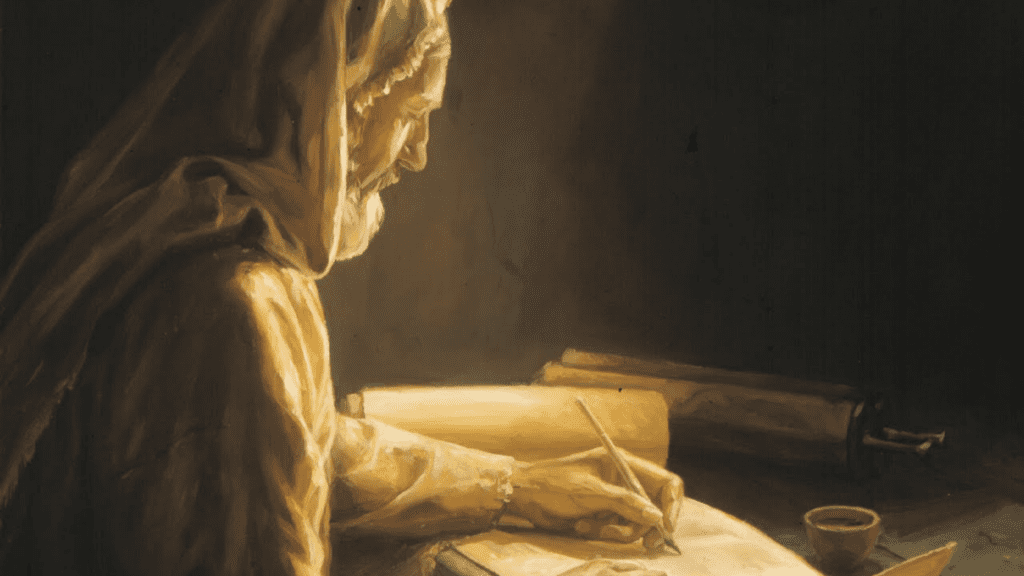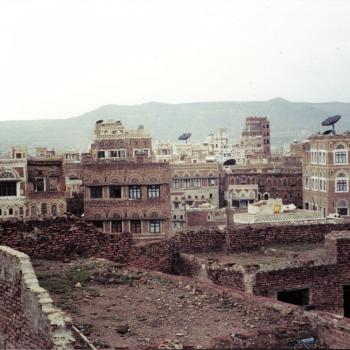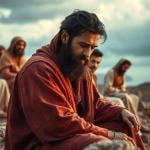Monday: Read Luke 7:1-35
The speech of Jesus in Luke 6 ended with Jesus’ question: “Why do you call Me, ‘Lord, Lord,’ and do not do what I say?” (6:46). Now, Luke narrates several stories that manifest how people respond to Jesus. More significantly these stories illustrate for us what love looks like.
The first episode involves a Roman centurion. As a Roman commander (in charge of 100 men), it was a good idea for him to win the favor of the local people (Jewish). So, he paid for the building of their synagogue. In the Roman world of patronage, however, that meant that the people were indebted to him. When one of his slaves becomes gravely ill, the people come to Jesus and ask him to help the centurion: “he is worthy” (4), they inform Jesus.
The centurion, however, realizes that Jesus is not in his debt. In fact, if Jesus were to enter his home and grant him this favor, then the centurion would be indebted to Jesus—something he would prefer to avoid.
So, he informs Jesus, “I am not worthy for you to come under my roof” (6). He believes in Jesus though. He asserts that if Jesus simply issued the command his servant will be healed. Jesus does so and replies that He has not found such great faith in Israel (9; this is what Elisha had done; cf 4:27; 2 Kings 5:1-14).
Jesus, then, raises the son of a widow (10-17; just like Elijah had done; 4:25-26; 1 Kings 17:17-24). The widow represents the epitome of the “poor.” With the death of her only son, and having no husband, the woman had no means of providing for herself. By raising her son, Jesus restores her hope and provides someone who can care for her well-being.
That a group from John the Baptist comes to ask if Jesus is the Messiah (19) or not is significant. If anyone knew that Jesus was the Messiah, it was John. He leaped in his mother’s womb when Mary arrived (1:41). He had seen the Spirit descend on Jesus at His baptism (John 1:32). Why did John doubt? Because what he saw and heard that Jesus was doing did not fit with his expectations of the Messiah. Where was Jesus’ army?
Jesus’ response confirms the upside-down nature of His kingdom: “Go and report to John what you have seen and heard: the blind receive sight, the lame walk, the lepers are cleansed, and the deaf hear, the dead are raised up, the poor have the gospel preached to them” (22).
Questions to ponder/discuss:
- Jesus’ command to love isn’t just about blessing the poor, it is about changing the world so that the poor are no longer poor! The woman whose son was dead and is now alive is no longer poor! What are some practical things that you can do to apply Jesus’ command to love in this way? (this might be a hard question that you’ll need some time to ponder).
Tuesday: Read Luke 7:36-8:3
The episode with Simon and the sinful woman highlights the differences between Rome’s cultural norms and the ethics of Jesus. In Rome, everything one does is to gain an advantage for oneself. For Jesus, everything one does is for the sake of those who cannot provide such advantages. The contrast between the sinful woman, who epitomizes the “poor,” and Simon illustrates Jesus’ words on love (6:20-49) and his words on forgiveness (4:18-19).
Jesus begins the confrontation with Simon with an illustration that affirms that the one who loves more is the one who is forgiven more (42-43). The woman’s act of worship is an expression of her love flowing from her debts being canceled (47).
- She probably met Jesus earlier and experienced His forgiveness. Then ran home to get the jar of perfume. Then, after finding out where Jesus was, she rushed in to anoint Him.
Simon, on the one hand, displays a greater concern for social conventions. He condemns the women and Jesus in order to salvage his dinner and the respect of his guest. Yet, his concerns for social norms somehow did not apply to Jesus. Simon dishonored Jesus by not doing the things that he was socially obligated to do. And then he calls into question the woman’s acts toward Jesus.
We noted in our study of 6:20-49 that Jesus defines love in such a way that is also restores a person to socially, economically, emotionally, etc. Jesus does this when He tells the woman, “go in peace” (50). The Aramaic would have been “shalom.” Shalom means, “may it be well with you.” It entails a wholeness that extends all aspects of one’s life. Jesus wasn’t just forgiving her sins. He was restoring her to the community and granting her wholeness of life.
Questions to ponder/discuss:
- How does this story and Jesus’ restoration of the women to society affect how we might take care of the “poor” today?
- How does this story match up with your community’s concern for the other?
Wednesday: Read Luke 8:4-39
Today’s reading has great stress on hearing: ‘He who has ears to hear’ (8); ‘Hearing they may not understand’ (10); ‘Hear’: (12, 13, 14, 15); ‘Take care how you listen’ (18); and ‘Hear the Word of God and do it’ (21).
For Luke, hearing is also accompanied by “believe” (12-13), “produce fruit” (14, 15), and “do it” (21).
The Parable of the Sower is often misunderstood. The point of the parable is what one does with the Word. Many suppose that the “good soil” that produced fruit (8, 15) had no rocky places or thorns. The reality, however, is that the “good soil” is the one that produces fruit despite the rocky places and the thorns.
The reference to the “lamp” that immediately follows (note: there is no break in Jesus’ words between 8:15-16) continues the parables of the Sower. Jesus is the Lamp. And He has not come to be hidden! Putting this together with the Parable of the Sower means that the seed that we are to sow is the proclamation of Jesus.
But making Him known will come at a cost (i.e., we will gain “rocks” [persecution] and will reap “thorns” [loss of comfort and security]).
The words of Jesus are revolutionary. Abiding by them will come at a price.
The miracles that follow (calming the storm and healing the demoniac) are paralleled in Mark 4. Luke incorporates them because they illustrate what “faith” looks like (25). Or, perhaps more appropriately, they demonstrate what the “good soil” looks like.
The demoniac, in fact, does exactly what the “good soil” is supposed to do: “he went away, proclaiming throughout the whole city what great things Jesus had done for him” (39)—in other words, he did not hide the lamp!
Questions to ponder/discuss:
- If we understand the “rocks” as suffering and persecution and the “thorns” as comfort, power, and privilege, is it possible that we too wander astray at times in order to avoid the thorns and the rocks? What might be some examples in which you have compromised your beliefs or ethics in order to avoid the thorns and the rocky places?
Thursday: Read Luke 8:40-9:11
The raising of Jairus’ daughter and the healing of the woman with the bleeding problem also illustrate what “faith” looks like (48, 50). Jesus’ command, “Do not be afraid any longer; only believe” (50) is as much for Luke’s readers as it was for the girl’s family.
In Luke 9, the theme turns to “discipleship.” Observe how often the disciples are mentioned in this chapter (1, 10, 12, 14, 18, 40, 43; specific disciples: 20, 28, 32, 33, 49).
The chapter begins and ends with instructions to the disciples (1-6; 43-50). They begin to share in Jesus’ ministry. Jesus sends them on a mission (1-6). We will comment on this mission again in Luke 22.
Questions to ponder/discuss:
- Too often the work of the kingdom is conceived of as something for the pastors and those with the training. Instead, the work of the kingdom is for all God’s people. We are all sent on mission—whether at work, school, or within the community. The task of putting the Lamp on the lampstand (8:16) belongs to us all. What is your mission field? Where has God placed you?
Friday: Read Luke 9:12-50
Luke 9:51-19:44 is an extensive section in which Jesus heads to Jerusalem (note 9:51, 53). Jesus begins to prepare His disciples for what they will experience.
This section begins with Jesus’ feeding of the 5,000 (12-17)—the only miracle of Jesus recorded in all four gospels. The multiplying of the food reminds the reader of the provision of manna at the time of Moses (cf Exodus 16; Numbers 11; 2 Kings 4:42-44). More than anything it serves as a reminder that Jesus is our source of life and sustenance.
If our reading of Luke and the gospels is correct, then those who accepted Jesus’ message likely found it even more challenging to survive in the midst of the Roman world. To give and not expect anything in return and to love the poor and the outcast would have hindered one’s ability to provide for one’s own well-being. That Jesus can multiply loaves serves as a reminder that He provides.
Jesus then questions the disciples as to who He is. This is the climactic moment in the synoptic Gospels (Matt 16:13-20; Mark 8:27-30; Luke 9:18-27). Before they head to Jerusalem, they must come to understand Who He is and what His mission is.
The disciples think they know who He is. Peter even confesses that Jesus is the Christ (20). But, as we have noted throughout our study, the disciples do not completely understand.
The part about suffering: “The Son of Man must suffer many things and be rejected by the elders and chief priests and scribes, and be killed and be raised up on the third day” (22) makes no sense to them.
Luke follows Mark by including Jesus’ demand, “If anyone wishes to come after Me, he must deny himself, and take up his cross daily and follow Me” (23). There are two things to observe in Luke’s version. First, Luke includes “daily” in the words of Jesus. Secondly, the grammar of the verse places more stress on “follow Me.”
Luke then includes the transfiguration of Jesus (28-45). Though the transfiguration helps to inform them who He really is, they still are struggling to figure it all out (43-45).
Questions to ponder/discuss:
- It is so easy for us to “spiritualize” Jesus’ words and in doing so soften what He says. The command to “follow Me” doesn’t simply mean, “go to church and be a good person.” It means “follow Me”: and where He is going is the cross! The challenge is to make this our “daily” prayer and to rely on the Holy Spirit to accomplish it.
[1] This guide is meant to be done either as a group study over the course of 2 or 4 meetings (Day 1-5; 6-10; 11-15; 16-20), or as a private devotion over the course of 4 weeks (or a calendar month—5 lessons per week).
NB: our goal is to keep these posts free of charge. I do not intend to ever hide them behind a paywall. I can only do this if those of you who have been blessed by them and can afford to give ($5, $10, $25, or more/month) do so. You can give a tax-deductible contribution by following this link.
Please share this post and let others know about determinetruth.
If you wish to view this blog on your smartphone through the Determinetruth app simply download the “tithe.ly church” app on your smartphone and insert “determinetruth” as the church name you wish to follow. Once it is loaded, simply click on the “blog” icon and they will automatically load.
If you would like to have Rob speak at your church or organization in person or via zoom, please let us know by filling out the contact info on the Contact me tab on this site.
















